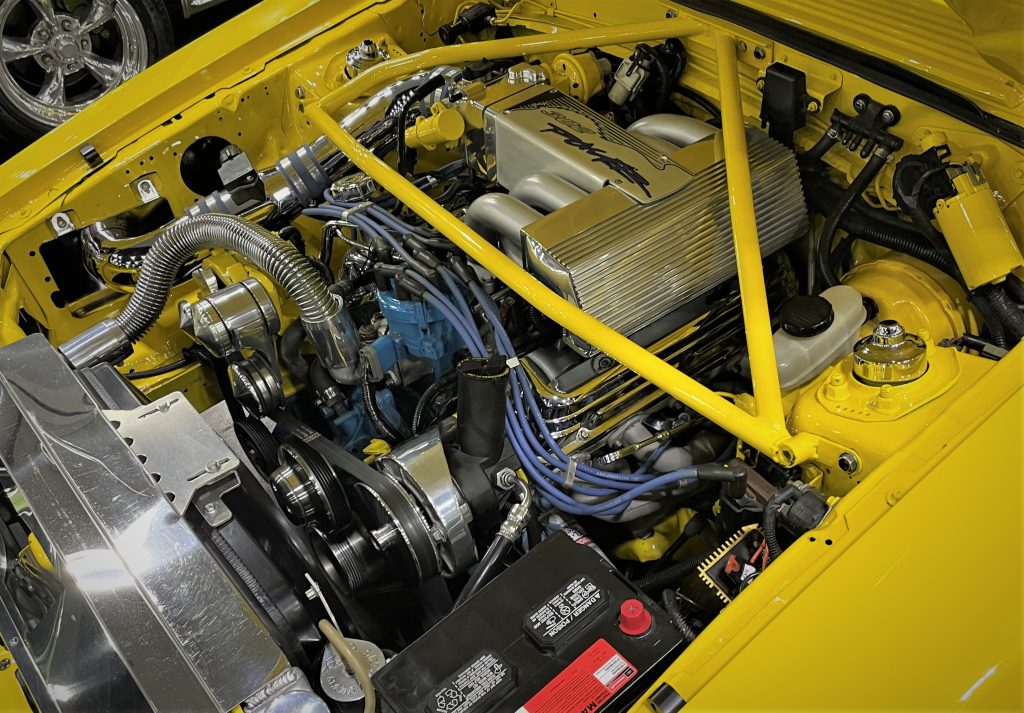Editor’s note: The 1980s was a transition period for engine technology in America. The iconic carburetor gave way to fuel injection. Cubic inches were out, and liter designations marked a new era for engines — one when power and fuel economy were no longer mutually exclusive. This modern engine age has featured some of the best innovation, technology, and performance yet.
#5 — Ford EFI 5.0L H.O.
The #5 entry on our list isn’t just an engine.
It’s a movement. A revolution of sorts.
Ford likely didn’t realize it at the time, but when the company added EFI to its existing 5.0L H.O. engine in 1986, it was creating a hot rodding craze. The small displacement engine (302 cubic inches) wasn’t all that powerful in stock form, but combined with the lightweight Fox-body Mustangs from the era, the Ford EFI 5.0L H.O. was plenty potent.
And at 225 horsepower, there was plenty of room for improvement.
The 5.0L’s H.O. stood for “high output,” but power-hungry Ford fanatics were hungry for higher output. Soon, there were entire magazines created and dedicated to hopping up 5.0L EFI-equipped Mustangs. There was a massive proliferation of Ford 5.0L aftermarket performance parts — so much so that Summit Racing even created an entire 5.0L section in its renowned big book catalog.
It was the aftermarket that turned the EFI 5.0L H.O. into a legend.
History
The Ford 5.0L was born in 1978 — or at least that’s when the 5.0L name first appeared.
The engine was basically a carryover from Ford’s venerable 302-cubic-inch Windsor V8, but Ford decided to make the switch to the European-style “liter” moniker. The Ford 5.0L didn’t really make a name for itself until the 5.0L H.O. was introduced for the new Mustang GT in 1982. The original 5.0L H.O. engines featured a 2-barrel carburetor (and later a 4-barrel) and made 157 horsepower. It wasn’t much, but it was a step in the right direction following the performance-depraved late 1970s. The 5.0L H.O. steadily gained horsepower over the next few years thanks to upgraded cylinder heads, a hydraulic roller cam, and other changes. EFI (electronic fuel injection) was finally added to the 5.0L H.O. in 1986 and a legend was born.
Or was it?
Although the EFI 5.0L H.O. produced more torque and offered excellent midrange power, peak power was actually down by 10 horsepower in the first year of EFI. Some enthusiasts feared the direct port injection technology, and many thought it would limit their ability to modify the engine. As Ford implemented changes to the EFI 5.0L H.O., the power numbers came around — and so did enthusiasts.
Power numbers jumped from 200 horsepower to 225 in 1987 as Ford refined the induction system. Aftermarket manufacturers took notice of the EFI 5.0L H.O.’s potential and the 5.0L performance parts boom began. Meanwhile, Ford continued to stoke the fire by creating a high-powered Cobra engine, which combined the EFI 5.0L H.O. with Ford Racing Performance Parts‘ hot GT-40 induction components.
The Windsor-based EFI 5.0L H.O. was gradually replaced by Ford’s new overhead-cam Mod Motor, but not before it:
- Restarted the Ford performance movement in the 1980s
- Launched the EFI performance era
- Established the Mustang Fox-body as a legit performance car
- Breathed life into a then-stagnant aftermarket parts industry
- Became one of the most modded hot rod engines in history — everything from budget-builds to full-on race mills
The EFI 5.0L H.O. continues to be an affordable performance engine. Its selection of aftermarket parts is rivaled only by that of the Gen. I small block Chevy. According to Summit Racing, popular upgrades include:


my fox has a 302 block stroked to a 347,it sits in a black coupe,not to much to it,its a very small car,but when the motor and stroke is put in a very light car,you have a car that people with much larger engines don’t want to mess with,mine has dynoed 450 hp.and weighs less than three thousand pounds,thats one hell of a power to weight ratio,and it has room for more power,by using a turbo or super charger
@ Charles Mills – Very cool! I’m about to drop a 347 stroker into mine, also. But be careful adding more hp to what you have. It’s been said that the 302W can only take about 500hp before the block cracks. Someone makes braces to avoid that, so I’d look into that before adding boost.
[…] its short six-year lifespan from 1990-95. While it didn’t create an entire movement like the Ford 5.0L or Cummins diesel, it does hold a special place in the hearts of Corvette aficionados. Created […]
[…] Engines are often identified by their displacement, like the ubiquitous Chevy 350, Mopar 440, or Ford Five-Oh. […]
[…] Download Image More @ http://www.onallcylinders.com […]
I have a 1987 5.0 ho efi that I put a b 303 cam in and now it burns realrich.what can I do
[…] Among the resources I’d gathered for the job was Mustang 5.0 Performance Projects, by Huw Evans from the Motorbooks Workshop. It turned out to be a valuable resource, providing a great deal of information on various upgrades for 1979 through 1995 Mustangs equipped with the 5.0L Windsor V8. […]
How much does the engine cost and how much hp is it